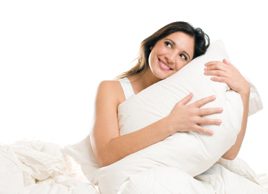How to choose a pillow
Bolster your chance of getting a good night’s sleep with this guide to pillow basics

Source: Best Health Magazine, January/February 2010
There’s no firm science to finding your perfect pillow’you just have to try a few until you find one that suits. The number of options in the marketplace is dizzying, but these basics will provide some, ahem, support for your quest.
Polyester
These synthetic pillows’often called ‘fibre fill,’ ‘microfibre’ or ‘cluster fill”are the most common type for sale in bedding stores. Polyester pillows need to be replaced every one to two years. Choose a different fill if you require more support for your head and neck.
Advantages: Inexpensive; machine-washable.
Disadvantages: Flatten easily; don’t last long; offer medium support at best;
harbour dust mites.
Price range: $10 to $60.
Latex
Ralph Rossdeutscher, president of Natura, a Cambridge, Ont., manufacturer of natural sleep products, says there are two types of latex pillows: foam core and granulated. Latex is firm and has excellent support, but not everyone likes its ‘springiness.’ In a recent study, latex pillows were better than polyester and feather for comfort and sleep quality, and testers had fewer complaints of neck pain.
Advantages: Last 15 to 20 years; offer significant support for head and neck; resistant to dust mites.
Disadvantages: Expensive; don’t breathe as well as others.
Price range: $50 to $90.
Memory foams
Memory foam’s heat-sensitive material’known as visco-elastic ‘moulds to the shape of your head and neck, so it’s important to lie down in the correct position. Developed by NASA for use in space capsules, memory foam comes in ‘soft’ and ‘firm’ options, and lasts 15 to 20 years.
Advantages: Recommended for people with neck and back pain or household allergies, and for pregnant women; resistant to dust mites.
Disadvantage: Expensive.
Price range: $60 to $180.
Feather and down
For those who like the plush factor, these pillows are hard to resist. They do need constant plumping but are good at regaining their shape. They generally last five to eight years.
Advantages: Last longer than polyester; lightweight.
Disadvantages: Less dur-able than latex or memory foam; poor support; can be expensive; may harbour dust mites.
Price range: Feather, $30 and up; down, $70 and up.
Wool
This natural fibre helps regulate body temperature and provides firm support and durability. It won’t shift, clump or hollow out over time, and is hypoallergenic. Wool wicks moisture away from the cover, ‘which prevents dust mites, mould and mildew from thriving, and it dries seven times faster than other fabrics,’ says Rossdeutscher.
Advantages: Last longer than polyester; resistant to dust mites; help to regulate body temperature.
Disadvantages: Expensive; offer firm support only.
Price range: $60 to $150.
Waterflow
‘There are a lot of pillows on the market, but only a few that have been clinically tested to see if they’re actually effective in changing people’s sleep and discomfort in the neck,’ says Anita Gross, a physiotherapist at LifeMark Physiotherapy in Hamilton, Ont., and associate clinical professor at McMaster University’s school of rehabilitation science. The waterflow pillow’the latest ‘buzz’ in the sleep world‘is one that has been through a clinical trial. It has a soft, hypoallergenic fibre filling supported by a water pouch. Users simply add or take away water to adjust the support level. ‘It’s the lower neck area that people over age 35 or 40 most commonly have problems with, and it’s that area where these pillows help,’ says Gross.
Advantages: Adjustable support level; good for neck pain.
Disadvantages: Expensive; can be fiddly, since you need to adjust the water level until it’s right for you.
Price: About $65.




